Hawa Mahal :
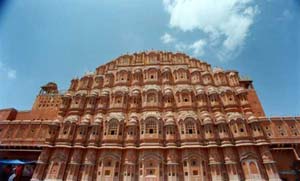
Built by the poet king Sawai Pratap Singh, the Hawa Mahal is the most strikingly
designed monument in Jaipur. What is seen from the Sireh Deorhi Bazaar is the five
story high backside of the complex ( see it in photo gallery ). It was conceived
to provide adequate vantage position behind delicate stone carved jali screens to
the palace women for watching the royal processions passing through the bazaar below.
|
Jantar Mantar :
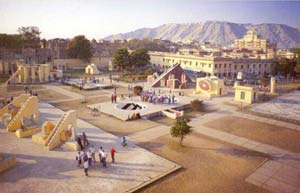
Jantar mantar is one of Jai Singh's five remarkable observatories. Constructed
with stone and marble its complex instruments whose settings and shapes are precisely
and scientifically designed represent the high points of Medieval Indian astronomy.
The Ram Yantras used for gauging altitudes are unique in their isolation. this is
the largest of the five observatories founded by Sawai Jai Singh-II in various parts
of the country. It has been listed in UNESCO world heritage sites.
Major Yantras or instruments that you can watch moving clockwise are: Small
'Samrat', 'Dhruva', 'Narivalya', The Observer's Seat, Small 'Kranti',
'Raj'
'Unnathamsa', 'Disha', 'Dakshina', Large 'Samrat',
'Rashivalayas', 'Jai Prakash', Small 'Ram', Large 'Ram Yantra',
'Diganta', Large 'Kranti'
|
City Palace :
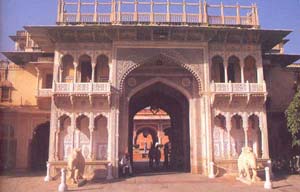
The City Palace is a historic landmark. The carved arches are supported by grey-white
marble columns studded with floral motifs in gold and coloured stones. Two elephants
carved in marble guard the entrance, where retainers whose families have served
generations of rulers are at hand to serve as guides.
The palace interior houses a Museum containing select collection of various types
of Rajasthani dresses, a fascinating armory of Mughal and Rajput weapons; swords
of all shapes and sizes, with chased handles, some of them inlaid, enamalled, encrusted
with jewels and encased in bold and magnificent scabbards.
It also has an art gallery with a fine collection of paintings, carpets, royal paraphernalia
and rare astronomical works in Arabic, Persian, Latin and Sanskrit, acquired by
Sawai Jai Singh-II for his study of planets and their movements.
|
Sargasuli :
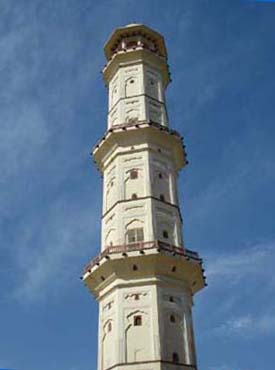
Also known as Isar Lat, this tower was erected in the mid-18th century by Maharaja
Ishwari Singh to commemorate a battle victory. Ironically, Ishwari Singh was ostracized
for his love of a common girl, and he is the only Kachchawaha maharaja who has not
been commemorated at Gaitore.The tower dominating the skyline on the western side
of Tripolia Bazaar is the highest structure in Jaipur.
|
Govind Devji Temple :

In the central pavilion of the sprawling Jai Niwas Garden to the north of the Chandra
Mahal is the spire less temple of Lord Krishna. the image in the form of Govind
Devji, originally installed in a temple of Vrindavan, was reinstalled here by Sawai
Jai Singh-II as his family deity. this is the most famous and popular temple in
Pink City attracting devotees from all over the country.
|
Albert Hall :
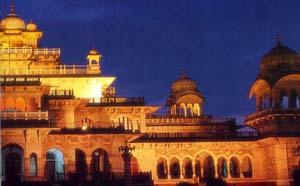
It is situated in the beautiful garden of Jaipur city, Ram Niwas Bagh. It was constructed
by Maharaja Sawai Ram Singh in the year 1886 under the drought relief work of Rs
4 Lacs.
The design of the building was done by Sir Swinton Jaicob. Presently the hall is
used for museum purpose.
|
Ram Niwas Bagh :
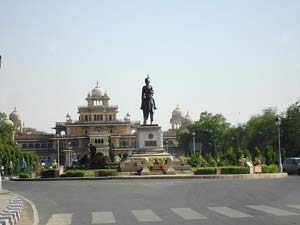
A garden planned by Maharaja Ram Singh in the 19th century as a famine relief project,
this extensive park consists of a zoo, aviary, herbarium museum and sports complex.
An added attraction is Albert Hall, designed by Sir Swinton Jacob, a British architect
who created palaces for many of the rulers of Rajasthan, and whose experiments with
Indo Saracenic architecture combined elements of English and north- Indian architecture.
Albert Hall is a museum and houses many curiosities.
|
B.M. Birla Planetarium :
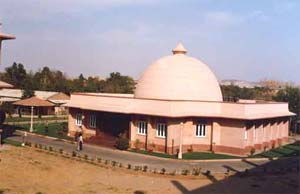
Equipped with modern computerized projection system, the planetarium offers unique
audio-visual educational entertainment. A Science Museum is also a part of this
one of the most modern planetarium in India.
|
Laxmi Narayan Temple (Birla Mandir) :

In the southern horizon is a privately owned hilltop fort of Moti Doongari shaped
like a scotish castle. At the foot of the hill, Laxmi Narayan Temple, beautifully
built in sparking white marble, is located.
|
Jal Mahal :

A tiny palace romantically located in the middle of a small lake, this was supposed
to be a hunting lodge for the royal family. It can only be viewed from the banks
of the lake.
|
Amer Fort :
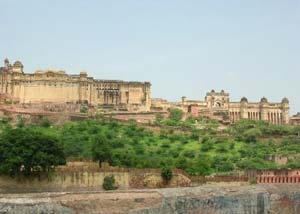
For seven long centuries before Jaipur was built, Amer served as the capital as
Kachhwaha rulers of the old state of Dhundhar.
Amer Fort is the complex of palaces, halls, pavilions, gardens and temples, which
were built by Raja Man Singh, Mirza Raja Jai Singh and Sawai Jai Singh over a period
of about two centuries.
The palace complex rising from the placid waters of the Mootha lake is approached
through a steep path, now often traversed by tourists on elephant-back, to Singh
palace and Jaleb Chowk. Two flights of stairs rise from one end to the chowk, one
leading to the elegant temple of Shila Mata and other to the palace complex. The
image of the Mother Goddess worshipped with reverence by thousands of devotees every
day was brought from Jessore in East Bengal (now in Bangladesh) by raja Man Singh
and installed here.
The front courtyard of the palace complex is dominated by the spectacular pillared
hall of the Diwan-e-Aam and the double storyed painted gateway Ganesh Pole. Beyond
the corridors and galleries on the either side of a small elegant Charbagh style
garden are Sukh Niwas to its right and Jas Mandir to its left. The Jas Mandir in
the upper floor combines the finest elements od mughal architecture and interior
decoration in a Rajput setting with intricately carved jali screens, delicate mirror
and stucco works and painted and carved dadodes. The older and simpler structures
at the far end were built by Raja Man Singh in the later year of the 16th century.
The well proportioned Mohan Bari or Kesar Kyari in the centre of the Mootha lake
and the Dilaram Bagh at its north end provide a spectacular view from the palaces
above.
|
Nahargarh Fort :
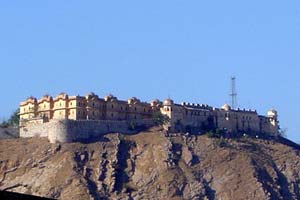
Beyond the hills of Jaigarh stand the Fort of Nahargarh like a watchful sentinel
guarding Sawai Jai Singh's beautiful city. Much of the original structures are now
in ruins, but the lovely building added by sawai Ram Singh II and Sawai Madho Singh
II still survive.
|
Jaigarh Fort :
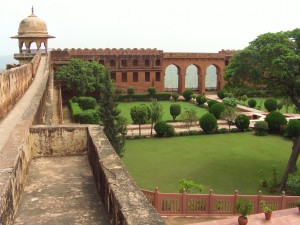
The western skyline is dominated by the extensive parkotas (walls), watch-towers
and gateways of jaigarh. It is one of the few military structures of the mediaeval
India preserved almost intact containing palaces, gardens, open and covered reservoirs,
a granary, an armoury, a well-planned cannon foundry, several temples, a tall tower
and a giant mounted cannon-the Jai Ban - the largest in the country.
|
Galtaji :

Beyond the gardens amidst the low hills guarding the city lies the old pilgrim centre
of Galtaji. Temples, pavilions and holy kunds ( natural springs and reservoirs )
do the serene green landscape. The small temple of the Sun God, built by Diwan Kriparam
on the top of the highest peak, is visible from all parts of the city.
|
Sisodia Rani Ka Bagh :
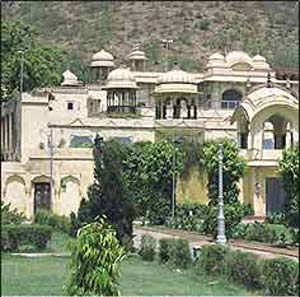
Along the road to Agra through a narrow gauge in the southern eastern corner of
the walled city, several landscaped gardens were constructed by the Kings and important
courtiers in the 18th and 19th centuries. The largest and the most famous is a garden
built by sawai jai Singh-II for his Sisodia queen-the Sisodia Rani Ka Bagh. It consists
of tiered multilevel gardens with fountains, watercourses and painted pavillions.
|
Gaitore :

Located off the Jaipur-Amber road, Gaitore is the final resting place for the maharajas
of Jaipur. Set in a narrow valley, the cenotaphs of the former rulers consist of
the somewhat typical chhatri or umbrella-shaped memorials. Of special mention is
Jai Singh IT's chhatri because of the carvings that have been used to embellish
it.
|
Amar Jawan Jyoti :

The Amar Jawan Jyoti memorial was built to honor the bravery of Rajasthan's legendary
martyrs and soldiers. Located at Janpath, Near Vidhan Sabha. Locals came here in
the evenings to marvel at the brilliant lighting effects. With the hue of the monument
magically changing from one vivid color to another.
|
World Trade Park :
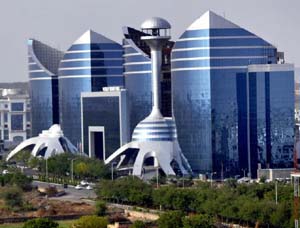
The World Trade Park (WTP) primarily underlines the concept of International Trade
and business activities all under one roof whereby providing its occupants through
its services and features world-class and worldwide connectivity to expand the reach
of their business, regular knowledge updation of the occupants for their trade and
giving exhaustive information relevant to their trade. The WTP would be providing
visitor with fully equipped and modern offices with the latest technical back-up,
Trade/ Exhibition Zones, Exhaustive Online Business Information, Business Centers,
High Speed Internet, Wireless LAN and much more. Further, it's not only about trade
and business but the WTP would also be providing you the best of leisure and entertainment
through its Club Lounges, Multiplexes, Food Courts, Auditoriums, Restaurants and
much more. The WTP would provide its occupants and visitors the best of work-culture
and pleasure.
|